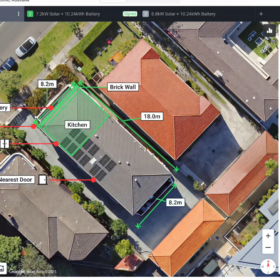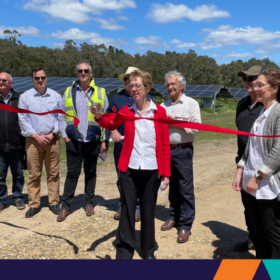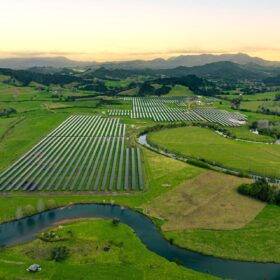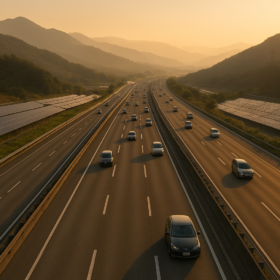Top News
Western Australia renewable energy generation delivers record on the SWIS

GreenSketch AI 3.0 fast tracks solar and battery install design and business

Salvation Army powers aid efforts with new agrivoltaic solar farm
Recording | pv magazine Week Europe 2025
Thank you for joining!
Great discussions and valuable insights were shared throughout the event.
Recordings of all sessions will be online soon.
Stay tuned!
Out now - pv magazine Global Winter Edition
The new pv magazine Global edition is out now!
Available in print and digital – get your copy today!
Upcoming Webinar
pv magazine Webinar

Lodestone generates first power from Pāmu Rā ki Whitianga solar farm

Japan launches call for road-surface solar technologies
FY2029 renewable energy construction spending to peak at $23 billion: report
Oodnadatta Track off grid project a blueprint for remote installations
Engineering trackers for Australia’s challenging environments
Press Releases
Faster renewable buildout and electrification key to affordable energy transition
Public liability for landholders neighbouring renewable energy projects clarified
Electric pools and solar powered sports halls across Tasmania with $2.2 million for bill busting upgrades
NSW EV Milestone: Over 100,000 electric vehicles registered, 121 million litres of petrol saved
Opinion & Analysis
Featured
Misleading chart overstates clean energy challenge
How mandatory climate reporting is raising the bar for corporate leadership
Around the world, businesses are entering a new era of accountability. The shift toward mandatory climate-related financial disclosures is transforming how organisations understand and govern key drivers of financial performance.
Coalition’s net zero retreat: Policies on line
In 2021, Australia’s Coalition government pledged to reach net zero by 2050. Four years later, the Coalition have reversed course. After successive election losses, the Liberal and National parties have settled on a new climate strategy: give up on net zero and keep coal plants running longer.
How Pacific nations plan to go from spending up to 25% of GDP on fossil fuels to running on 100% renewables
Picture dusk falling somewhere in the Solomon Islands. A fisher’s skiff glides home using a whisper-quiet electric outboard motor. In the Cook Islands, a big battery steadies the island grid. In Papua New Guinea’s highlands, solar kits bring electric light to homes for the first time.
Three hours of free power sounds great – but it could raise other costs and hamstring rooftop solar
It was the news that rippled around the nation – and then the world: at least three hours of free grid-supplied electricity for Australian households, every day.
Why resilience won’t future-proof Australia’s supply chains
The last five years have placed unprecedented strain on global supply chains. Geopolitical tensions, trade wars, natural disasters and the global pandemic have revealed vulnerabilities across industries.
Markets & Policy
Featured
6 GWh CATL battery in Australia: Stanwell locks in massive gas-plus-storage hybrid plant with Quinbrook
Modo Energy raises $50 million and sets out AI ambitions
Venture capital firm Molten Ventures leads investment in global battery energy storage benchmarking business Modo Energy. Founded in the United Kingdom in 2019, Modo Energy has expanded to cover continental European markets, Australia and the United States.
Zenith reaches agreement for gold mine renewables
Remote power specialist Zenith Energy has signed on to deliver a hybrid renewable energy system – including 138 MW of solar and a 300 MWh battery – to help power Northern Star Resources’ gold mining operations near Kalgoorlie-Boulder in Western Australia.
Rooftop solar install rates reach 2025 high
The latest monthly update from market analyst SunWiz shows 279 MW of new rooftop solar capacity was registered across Australia in November 2025, up 28 MW on the 251 MW that was installed during the previous month.
TagEnergy locks in long-term toll deal for Golden Plains battery
Renewables developer TagEnergy has locked in the first long-term offtake deal for the 150 MW / 600 MWh Golden Plains battery project being built in Victoria’s western districts.
Sunman to build 500 MW solar panel manufacturing plant in NSW
Chinese manufacturer Sunman is to build a 500 MW per annum solar module production facility in the New South Wales Hunter Valley after securing funding support from both the state and federal governments.
Installations
Featured
Panasonic glass-based perovskite solar panels tested in office windows
Study shows optimal solar-plus-storage sizing for heavy industry operation
Australian researchers developed a high-resolution energy modeling framework to assess how PV and batteries can supply 24/7 electricity to heavy industries, considering cost, grid interaction, and load flexibility. They found that while technology cost reductions help, smart grid integration and flexible industrial operations are far more effective in lowering electricity costs and enabling 100% renewable energy use.
Trina Storage launches AC-coupled battery for utility-scale applications
Offered primarily as a 10 MW unit, the new product is also available in a 5.5 MW version for customers with specific requirements.
Plico eyes national rooftop solar and storage rollout with CEFC support
Western Australian clean energy tech provider Plico will target all states and territories with its combined rooftop solar, home batteries and virtual power plant offering after securing up to $35 million in federal government funding.
Fortescue delivers big battery to support Pilbara plans
Mining giant Fortescue’s decarbonisation plans have reached a new milestone with the delivery of a 50 MW / 250 MWh battery energy storage system at its North Star Junction site in Western Australia’s Pilbara region.
Synchronous condensers to play key role in system security says AEMO
The Australian Energy Market Operator says “timely investments” are essential to unlock the full value of renewables and reduce reliance on coal generators for system security as the nation’s clean energy transition continues.
Technology
Featured
Built-in solar helps cut cold storage power usage
JinkoSolar achieves 34.76% efficiency for perovskite-silicon tandem solar cell
JinkoSolar says it has increased the efficiency rating for its perovskite-silicon tandem solar cells from 34.22% to 34.76%, confirmed by China’s National PV Metric and Testing Centre.
NEM dispatchable capacity CIS Tender 8 opens, targets 16 GWh
Undertaking a fast tracked, single stage application process the Capacity Investment Scheme Tender 8 – NEM Dispatchable Capacity has opened for registrations and is targeting 4 GW of 4-hour equivalent.
Connected and islandable microgrid project launched in New South Wales
A collaborative project focussing on the development of connected and islandable microgrids within the Australian distribution network has been launched in New South Wales.
Tindo’s road ahead paved with funds, challenges and future-proofed growth
pv magazine spoke with Australian solar panel manufacturer Tindo Chief Executive Officer Richard Petterson about the company’s future expansion on the back of Solar Sunshot funding, and how it plans to tackle current market and manufacturing challenges to stay on course for future growth.
JinkoSolar achieves world record efficiency of 27.79% for TOPCon solar cell
The Chinese manufacturer says Germany’s Institute for Solar Energy Research Hamelin (ISFH) has independently verified the result.
Manufacturing
Featured
Huasun unveils 770 W, 2,000 V heterojunction solar module
First Graphene and Halocell seal deal on graphene-based carbon paste
Graphene producer First Graphene has secured exclusive global graphene carbon paste production and sales rights with perovskite cell developer and manufacturer Halocell Australia.
ChasingLight Technology launches indoor organic PV modules
The China-based organic photovoltaics manufacturer has launched a line of indoor PV modules suitable for integration into digital office products and electronic devices.
Sigenergy points to installation practices for product recall
Sigenergy says the issue that has prompted a voluntary recall of the company’s 8 kW, 10 kW and 12 kW single-phase inverters in Australia and New Zealand stems from incorrect installation practices, not a product defect.
Longi reveals details of world’s most efficient silicon solar cell
In a new scientific paper, the Chinese solar manufacturer explained that the 27.81%-efficient hybrid interdigitated back-contact cell it unveiled in April is based on passivated tunneling contacts and dielectric passivation layers, while also incorporating both n-type and p-type contacts.
Sinovoltaics releases new PV inverter manufacturer financial stability ranking
The quality assurance firm updated its inverter manufacturer financial stability ranking with Kstar Science and Technology, APSystems and Delta Electronics in the top three spots. It reported 19 manufacturers showing “strong financial resilience” based on Altman-Z scores.
Energy Storage
Featured
Global grid-scale BESS deployment up 38% year-on-year through October
New renewable generation capacity in 2025 on track for 7 GW: report
The Clean Energy Regulator’s Q3 2025 quarterly carbon market report has found Australia is on track to add nearly 7 GW of new renewable generation capacity in 2025, with large-scale projects contributing up to 4 GW.
Ampyr inks $300 million long term agreement for Bulabul BESS
Ampyr Australia has signed a 15-year agreement for its Bulabul battery energy storage system near Wellington, New South Wales, in the Central West Orana renewable energy zone with Danish energy trading company InCommodoties.
Distributed energy resources test lab opens in Western Australia
Western Power has launched Western Australia’s first distributed energy resources text lab at it’s South Metro Depot to trial how rooftop solar, batteries, electric vehicles and smart appliances can connect, communicate and interact.
FRV seeks federal tick for NSW solar farm and beefed up battery
A redesigned hybrid solar and battery project now featuring 200 MW of PV generation and a beefed up 2.2 GWh of energy storage capacity planned for far northern New South Wales has joined the queue for federal environmental approval.
Engie breaks ground on South Australian battery
French-owned energy group Engie has commenced construction of a new large-scale battery that is says will deliver more capacity and flexibility to the South Australian electricity grid.


